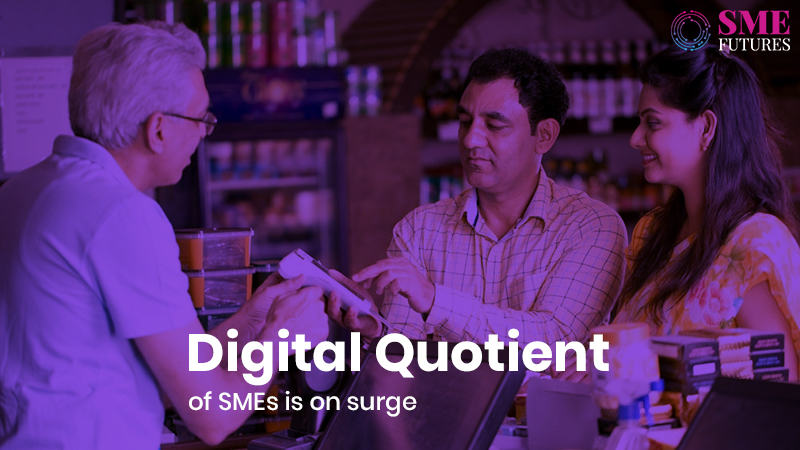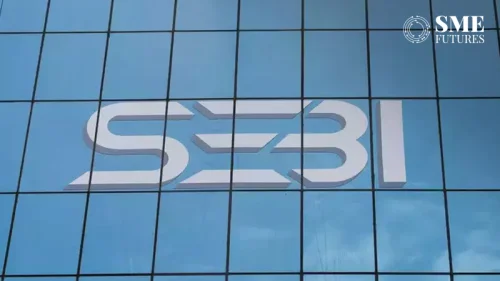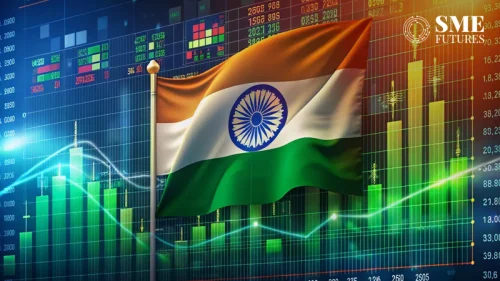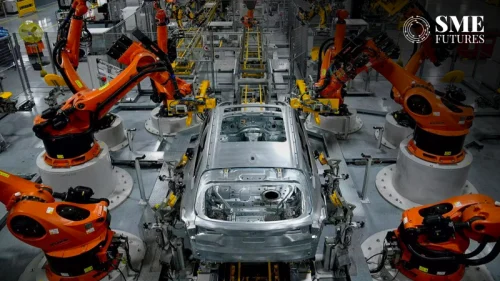The year 2020 was the time for a sea change for small and medium businesses.
Punekar and tea shop owner, Sunita Anil Agarwal saw it all in the past year, when the lockdowns hit her business hard at least for the first three months. She typically deals with low value, high volume transactions. However, she had already opted for digital solutions for the record keeping of her transactions from Khatabook which did a lot to minimise the negative impact on her business. “Going digital is a gamechanger,” she says. Now she manages sales records on credit digitally, sends reminders to customers for payments and the need for manual bahi khatas has been completely eliminated for her.
Another small business KV Pai and Sons, a 120-year-old legacy business in Udupi shifted its business operations on to the digital platform with eSamudaay. “It was time to move to the digital platform,” says Ajesh Pai, the current owner.
There are thousands of stories like this of how the pandemic has brought about a paradigm shift for the small and medium business owners in India, irrespective of the sectors they are in and pushed them to go digital. But the most important fact is that the Indian SMEs have realised that digital transformation is the key to surviving the current and future crises.
Let’s see how businesses across India have embraced digital transformation and evaluate a few of the current trends in this regard.
Rapid digital change
“Digital adoption has been on for some time now, but slightly less in the SME space,” says Srikanth Srinivasan, VP & Head, Membership and Outreach at NASSCOM. “But the pandemic has accelerated the pace,” he said during a virtual MSME summit event by DELL.
This has been one fact that we can’t ignore.
Previously, in the pre-COVID era, promoting digital adoption by SMEs appeared to be a far-fetched mission. But COVID-19 has accelerated technology adoption by several years.
And the reasons are many such as- in the present scenario, due to COVID-19, more and more consumers are shopping online, leading to a boost in e-commerce sales; this provides SMBs a valid reason to transform and build on digitisation. Reports suggest that the digital transformation market has grown at a 23 per cent CAGR. As per estimates, it will be a US$ 3.3 trillion market by 2025.
“During this time, small businesses have been grappling with drastically reduced liquidity, disrupted supply chains and lending challenges. To bounce back, they need to pivot and adapt swiftly, reimagine their business models, and identify their place and role in the new normal. In these efforts, most small businesses have realised that going digital is critical and are displaying a willingness to disrupt themselves,”
according to Panish PK, Managing Director, SMB, Cisco India and SAARC.
There are some other factors at play as well that are responsible for this accelerated digital transformation.
“Some of the factors that have helped digitalisation to become more prevalent are seamless communication and connectivity,” Raj Kumar Rishi, VP and MD, Consumer and Small Business, Dell India opines in the webinar. “As far as businesses are concerned, the biggest impact, in my mind, that digitalisation has made is in terms of democratising the entire business environment,” he said.
For instance, Amazon India whose business model revolves around on boarding small and medium resellers, has onboarded 300,000 new sellers since January 2020. The e-commerce giant has also helped to create nearly three lakh direct and indirect jobs since January 2020.
“We have seen more than 50,000 neighborhood stores or kirana stores who have joined our Local Shops on Amazon program. At the same time, it took us the first few years to enable the first billion dollars of exports. The second billion came in 18 months, and the third billion just took 12 months,” Manish Tiwary, Vice President, Amazon India said in a statement.
According to company officials, Amazon India, has already enabled over $3 billion in cumulative exports and already digitised about 2.5 million MSMEs in the country.
The number of entities going digital on a single platform such as Amazon India indicates the level of awareness among small businesses about going online. This is incontrovertible evidence of the paradigm shift that has occurred in the Indian business landscape due to digital transformation. Experts strongly feel that businesses are emerging as digitally matured, are becoming more resilient and are successfully countering various challenges, whether they be about their on-ground operations or resource constraints.
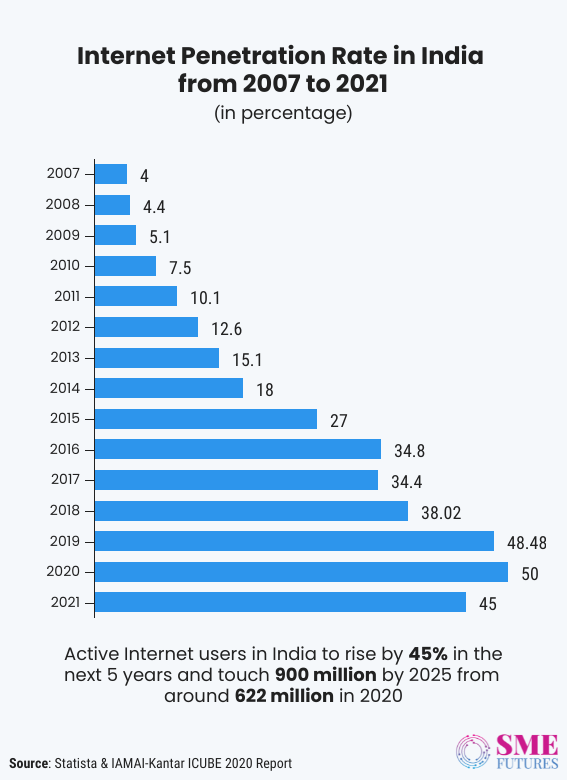
MSMEs have evolved through digitalisation
Revelations by a 2017 study by Google and KPMG show that digital businesses tend to make up to twice the revenue and profits generated by their offline counterparts. Moreover, the adoption of digital solutions opens them up to new market opportunities. This not only boosts their revenue, but also allows them to employ up to five times more people than they would have otherwise.
In the current situation, this precedent appears to be ideal.
Many businesses that used digital solutions were able to survive the pandemic’s financial crises. CRISIL Ratings conducted a survey during the lockdowns to assess this fact. According to the survey findings, approximately 60 per cent out of 566 companies with less than Rs 25 crore in revenue that transitioned to selling via digital platforms said that it helped them to survive, while the remaining said that it provided growth.
However, prior to the pandemic, only about 29 per cent of the MSMEs surveyed were using digital sales channels such as online aggregators or marketplaces, social media, and mobile marketing, while the others transitioned post-pandemic. According to the survey, this increased to 53 per cent among small businesses and 47 per cent among micro businesses in November.
Despite their limitations, micro enterprises are not far behind small businesses in terms of digital adoption, according to Crisil Director Bhushan Parekh, and many of them are indicating that they will follow suit soon.
In the manufacturing sector, gems and jewellery and textiles showed the most improvement, it said.
At the same time, not only are the companies growing, but so are the solution providers.
ACKO, a digital insurance company, is a perfect example of how increasing digital adoption has contributed to their growth. The firm has gained more than a 120 per cent increase in the number of auto insurance policies sold in Q1 FY 22 vs Q1 FY 21.
“What the pandemic has done is accelerated the shift to digital and the comfort of transacting digitally, across generations,” says, Animesh Das, Head of Product Strategy at ACKO, commenting on this growth via increased digital adoption.
Recently ACKO has posted Rs 81 crores in Gross Written Premium in the Q1 of FY 22, registering a growth of 1.16X for their auto business when compared to the same quarter of FY 21. Besides that, their new customer base from non-metro cities grew by 3.5X in the same year while it grew by 2.5X in the metro cities, signalling a confirmed shift in customer’s digital experiences across industries, including insurance.
“Since its launch, ACKO’s approach of being digital first, has been the disruptor of the traditional insurance model. Adding to that the last one year has been definitive in terms of customer’s demands as the convenience, value and experience of the digital medium got reinforced. We’ve been ready and poised to capture this growing demand,” he adds.
Another player, eSamudaay, which helps local businesses go digital by setting up e-stores, feels the same way and attributes the platform’s growth to the crisis brought about by the pandemic.
“Since 2020, COVID has placed the need for digital transformation front and centre for businesses of all types and sizes. COVID has also triggered an acceleration in consumer buying to migrate to (drop large) digital platforms,”
says Ravi Haldipur, Co-founder & Head of business development at eSamudaay
Going further, Haldipur sees the scenario as positive not only for the local micro businesses but for themselves as well. The platform aims to empower as many as over 2000 local e-commerce platforms over the next few months. He informs us that eSamudaay’s mission is to decentralise digital technology. “We envision the emergence of local digital platforms and a network of decentralised autonomous organisations, each being a locally owned company operating a local digital marketplace for the benefit of the local community. Our partner merchants have seen a steady increase in revenue and a greater market reach by moving their businesses online with eSamudaay,” avers Haldipur.
To put it simply, from an optimistic perspective, this crisis has been the best impetus for MSMEs to go digital.
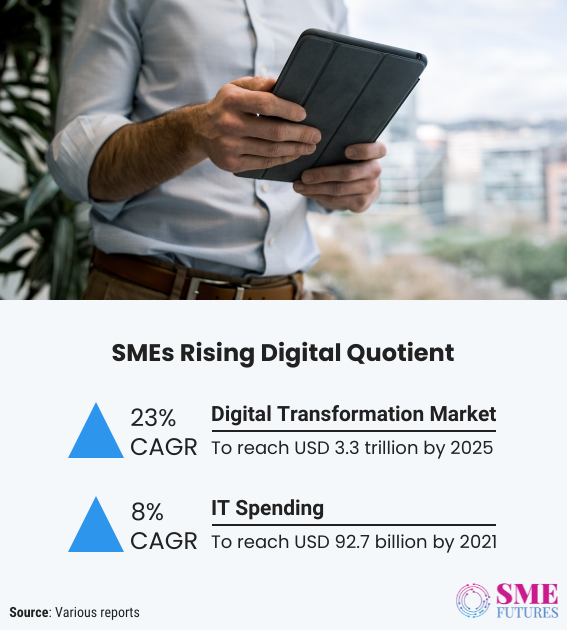
IT spending is surging upwards
With accelerated digital adoption, the IT spending of businesses including small firms has also skyrocketed. The latest Gartner analysis projects worldwide show that IT spending was at a total of $4.2 trillion in 2021, which is an increase of 8.6 per cent from 2020.
Meanwhile in India, IT spending is expected to reach $92.7 billion in 2021, growing 8 per cent from last year, as many companies are still suffering due to declining revenues and IT spending is accelerating ahead of revenue expectations amid the pandemic.
According to the experts, despite the sluggishness in the economy due to the successive waves of the pandemic, Indian SMEs are now better positioned to invest more in IT solutions.
“The second wave of the pandemic and associated lockdowns have brought a significant sluggishness during most of the second quarter of 2021. However, demand is witnessing a rapid recovery across a majority of the sectors,” said Naveen Mishra, senior research director at Gartner. “Pharma, healthcare, financial services, education, online retail and the government continue to invest in their digital transformation journeys,” he further said.
“Customer-centric companies have prioritised and preponed their digital transformation plans by at least 2-3 years to offer a better customer experience. Enterprises have invested or are planning to invest in technologies like ERPS, CRMs, and other digital platforms to achieve greater value and positively impact their bottom lines.”
Ritesh Pandey, Co-founder and Director-Sales at CocoonIT Services says,
Gartner assesses that this trend of increased IT spending will continue, especially for the SMEs.
End users are forecasted to spend the highest on devices in 2021, after a 5.9 per cent decline in 2020. “CIOs are looking for partners who can think past the digital sprints of 2020 and be more intentional in their digital transformation efforts in 2021. This means building technologies and services that don’t yet exist, and further differentiating their organisation in an already crowded market,” said Gartner.
Digital engagement is the new normal
Just digest these facts…
In July 2020, the average share of digital customer interactions was 58 per cent globally, a marked increase from 36 per cent in December 2019.
In 2020, e-commerce was responsible for 17 per cent of the global retail trade, compared to 14 per cent in 2019.
The percentage of digital products and services stood at 55 per cent in July 2020 compared to 35 per cent in December 2019 – a marked 20 per cent increase in 6 months!
Given these figures, it’s clear that the pandemic has brought in its wake two major realisations for the MSMEs—the need to connect more closely with consumers and the need to go online at all costs. And those who did are faring well.
“The only way SMEs can be ahead of technology is by adopting it,” says Prerna Kalra, CEO at Daalchini Technologies, an IOT based vending machine provider. “The world is at an interesting cusp, where to be in the game what matters most is how you upgrade, up-skill and upscale the business faster than the technology advancements that make you obsolete. Now an SME can create its online store within a minute, accept digital payments, manage their ledger on smartphones, etc. All these factors have helped SMEs to focus on their core business and grow after the second wave of the COVID-19 pandemic,” she added.
Thus, India is seeing a rise in the multiple channels that are being employed to communicate with consumers along with a rise in the number of D2C brands across verticals, be it FMCG, apparel, healthcare or electronics or any other service. A market analysis on D2C brands estimates that more than 800 brands took the D2C route to address their consumers demands directly. In fact, the D2C market in India is projected to grow to a $100 billion by 2025.
At the same time, this also led to 71 per cent of the customers spending more time online than earlier, which is a major reason to accelerate the adoption of digital solutions to ensure continued user engagement.
Adding his thoughts, Avlesh Singh, Co-founder & CEO, WebEngage says, “The need of the hour is for companies to step up and provide humanized and personal experiences to their customers across multiple touchpoints. Marketers must prioritise the intelligent utilisation of customer data to engage the new-age digital-first consumer effectively. This change is here to stay, and the trends will ring true all through 2021 and beyond, making it crucial for brands to step up their digital engagement.”
Digital transactions have replaced cash
Traditionally, businesses were content with the cash driven economy. But the pandemic has busted various myths around cashless transactions and made it a preferred channel.
Digital transactions have reached a total of over Rs 53 billion in FY2021, which is a remarkable increase from Rs 20.7 billion in FY2018.
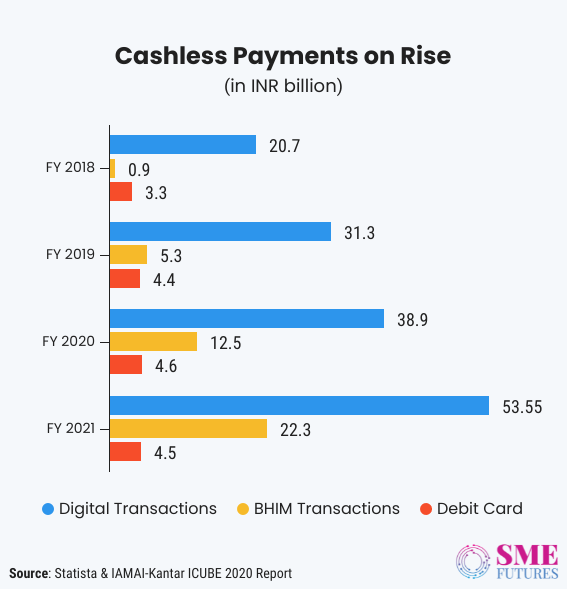
Whereas an RBI analysis states that the share of digital transactions in the total volume of non-cash retail payments increased to 98.5 per cent during 2020- 21, up from 97 per cent in the previous year.
Among the cashless payment options, the mobile payment app BHIM (Bharat Interface for Money) overtook debit card payments from 2018. The value of BHIM transactions increased significantly between 2018 and 2021. Also, the number of Points of Sale (PoS) terminals increased by 6.5 per cent to 47.20 lakhs and the number of Bharat Quick Response (BQR) codes deployed increased by 76 per cent to 35.70 lakhs by the end of March 2021. Further, the number of ATMs marginally increased by 2 per cent from 2.34 lakh at the end of March 2020 to 2.38 lakh at the end of March 2021.
In the last 5 years, the number of credit cards issued has grown from 211 lakhs to over 550 lakhs, and the debit card number has grown from 5,535 Lakhs to over 8,000 Lakhs.
Talking about the rise of the cashless economy and digital payments, Gaurav Anand, CEO at, Namaste Credits says that SMEs can be seen as a case of an acute dichotomy. While on one hand they have been the most badly impacted segment, but at the other end of the spectrum, they have been the fast movers on the digital adoption front, more than the others.
“From digital payments to vendors to GST payments, from digital sales to digital loans, all major SME activities have seen massive digitisation and increasing digital adoption. A lot of the credit goes to the ever-burgeoning fintech ecosystem in India which is seeing a tremendous opportunity from getting the brick & mortar businesses to embrace the digital footprint! We see this trend only getting stronger as going digital ensures lower cost of doing business and brings a significant footprint to the formal economy for MSMEs,”
Gaurav Anand, CEO at, Namaste Credits, comments
Besides the pandemic, the Indian payment space has grown over the years as a result of the rampant increase in internet and mobile users, affordable internet connectivity, a surge in mobile platforms, and simple interfaces.
Given this positive momentum, industry experts believe that payment digitisation has created an entirely new payment platform sector with enormous potential in India. According to ResearchAndMarkets analysis, the Indian payment market will reach Rs 280.84 trillion by 2027 from Rs 101 trillion in 2020, growing at a CAGR of 15.73 per cent during 2020-2027.
What’s the bottom line
With the development of the digital economy, and the current COVID-19 crisis, the future of the global economy will have everything to do with digitalisation. And SMEs are a cornerstone of the economic development in India, accounting for nearly 30 per cent of India’s GDP.
Having said that, when faced with changes, SMEs should embrace digital technologies and promote digitalisation.
“Technology can contribute towards equating opportunities. And the MSMEs in India are not tech shy,” says Ravish Naresh, CEO and Co-founder at Khatabook.
But of course, there are some challenges too.
According to him digitisation still needs to penetrate to the hinterlands of India where digital adoption is slow.
“More than half of India’s MSMEs operate out of rural India. The slow digital adoption in India, partly, has been the outcome of the technology innovations not being cantered around the digital needs of users from the hinterlands of Bharat. As tech enablers for MSMEs, we need to be relevant by making digital more regional and language inclusive. The tech made for India should reflect the diversity of the Indian MSMEs to be transformative for the ecosystem,” says Naresh.
He further adds that Khatabook is continuously working on that narrative. “The company paid a great deal of attention to user empathy. We created a simple app that fits the behavioural needs of MSMEs across India with the option to use it in 13 Indian languages. As a result, MSMEs across almost all Indian districts adopted the technology,” he adds.
On the other hand, another challenge that SMEs face during digital transformation is the lack of information and education. Also, every SME has different requirements and different ways of navigating the digital landscape. That means you can’t standardise them with one simple solution.
This is one major challenge for IT service providers when it comes to servicing SMEs, says Kalra of Daalchini Tech. “There is no one-size-fits-all solution available to them, hence there is a need for constant up-gradation, optimisation, and focusing on the core while utilising technology to scale non-core activities and this can help SMEs with this challenge,” she asserts.
Another grey area that SMEs had to focus on is cybersecurity.
According to Fortinet’s Cybersecurity survey report 2021, 9 out of 10 organisations experienced at least one intrusion in the past year and 63 per cent had 3 or more intrusions, which is similar to the results of their 2020 survey.
The cyberbreaches reportedly impact an organisation in various ways, hence, IT field experts suggest to essentially invest in reliable cybersecurity measures.
“Companies that suffer data breaches sell for lower values than they normally would have based on their financial health and performance. It has also been reported that companies that suffered data breaches lost their stock value by 7.5 per cent. This is primarily caused due to the perceived loss in reputation and the consequent loss in market share. An advanced firewall acts as a potent layer of protection against all threats, from planned attacks by hackers to unintentional data leaks by employees. It helps secure remote users of the organisation and helps organisations to remain valuable and trustworthy for not just their customers but also their investors and partners,”
says Sonit Jain, CEO of GajShield Infotech.
The way forward
Over the years, digital transformation has been the core focus point for the small and medium businesses in India. Considering their growth potential, the digitalisation of small and medium businesses could add $158 to $216 billion to India’s GDP by 2024 and contribute greatly to the country’s economic recovery post COVID-19.
Having said that, SMBs that are more digitally mature enjoy twice as many benefits in terms of revenue and productivity than dos those who have an indifferent approach to digitalisation. Meanwhile, in the past few months, a new breed of digital SMEs is emerging and setting up the narrative for other micro businesses as well.

